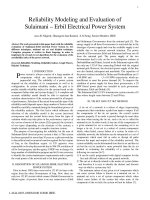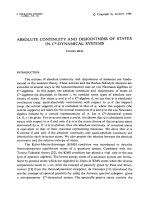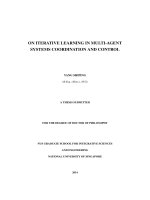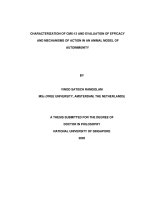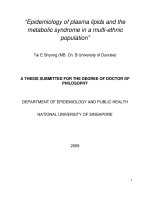Modeling and evaluation of trusts in multi agent systems
Bạn đang xem bản rút gọn của tài liệu. Xem và tải ngay bản đầy đủ của tài liệu tại đây (516.97 KB, 113 trang )
Modeling and Evaluation of Trusts in Multi-Agent Systems
GUO LEI
(B. ENG. XI’AN JIAO TONG UNIVERSITY)
A THESIS SUBMITTED
FOR THE DEGREE OF MASTER OF ENGINEERING
DEPARTMENT OF INDUSTRIAL & SYSTEMS ENGINEERING
NATIONAL UNIVERSITY OF SINGAPORE
2007
Acknowledgement
ACKNOWLEDGEMENT
First of all, I would like to express my sincere appreciation to my supervisor,
Associate Professor Poh Kim Leng for his gracious guidance, a global view of
research, strong encouragement and detailed recommendations throughout the course
of this research. His patience, encouragement and support always gave me great
motivation and confidence in conquering the difficulties encountered in the study. His
kindness will always be gratefully remembered.
I would like to express my sincere thanks to the National University of Singapore and
the Department of Industrial & Systems Engineering for providing me with this great
opportunity and resource to conduct this research work.
Finally, I wish to express my deep gratitude to my parents, sister,brother and my
husband for their endless love and support. This thesis is dedicated to my parents.
i
Table of Contents
TABLE OF CONTENTS
ACKNOWLEDGEMENT...........................................................................................I
TABLE OF CONTENTS .......................................................................................... II
SUMMARY ...............................................................................................................IV
LIST OF FIGURES ..................................................................................................VI
LIST OF TABLES .................................................................................................VIII
1.
2
INTRODUCTION............................................................................................... 1
1.1.
BACKGROUND ................................................................................................ 1
1.2
MOTIVATIONS ................................................................................................ 2
1.3
METHODOLOGY ............................................................................................. 3
1.4
CONTRIBUTIONS ............................................................................................ 4
1.5
ORGANIZATION OF THE THESIS ...................................................................... 5
LITERATURE REVIEW .................................................................................. 6
2.1
3
TRUST ............................................................................................................ 6
2.1.1
What Is Trust?....................................................................................... 6
2.1.2
Definition of Trust................................................................................. 7
2.1.3
Characteristics of Trust ........................................................................ 8
2.2
REPUTATION .................................................................................................. 9
2.3
TRUST MANAGEMENT APPROACH IN MULTI-AGENT SYSTEMS .................... 11
2.3.1
Policy-based Trust Management Systems ........................................... 12
2.3.2
Reputation-based Trust Management Systems.................................... 14
2.3.3
Social Network-based Trust Management Systems............................. 19
2.4
TRUST PROPAGATION MECHANISMS IN TRUST GRAPH ................................ 23
2.5
RESEARCH GAPS .......................................................................................... 30
TRUST MODELING AND TRUST NETWORK CONSTRUCTION ....... 32
3.1
TRUST MODELING........................................................................................ 33
ii
Table of Contents
3.1.1
Basic Notation..................................................................................... 33
3.1.2
Modeling ............................................................................................. 34
3.2
4
3.2.1
Trust Transitivity ................................................................................. 38
3.2.2
Trust Network Construction................................................................ 39
TRUSTWORTHINESS EVALUATION........................................................ 44
4.1
Introduction......................................................................................... 44
4.1.2
The Proposed Approach...................................................................... 48
NUMERICAL EXAMPLE ................................................................................. 54
EXPERIMENTS AND RESULTS .................................................................. 58
5.1
EXPERIMENTAL SYSTEM .............................................................................. 58
5.2
EXPERIMENTAL METHODOLOGY.................................................................. 64
5.3
RESULTS ...................................................................................................... 66
5.3.1
Overall Performance of Bayesian-based Inference Approach ........... 66
5.3.2
Comparison of with and without Combining Recommendations........ 70
5.3.3
The effects of dynamism ...................................................................... 71
5.4
6
EVALUATION ............................................................................................... 44
4.1.1
4.2
5
TRUST NETWORK CONSTRUCTION ............................................................... 38
SUMMARY .................................................................................................... 77
CONCLUSIONS AND FUTURE WORK ...................................................... 78
6.1
SUMMARY OF CONTRIBUTIONS .................................................................... 78
6.2
RECOMMENDATIONS FOR FUTURE WORK .................................................... 80
REFERENCES.......................................................................................................... 82
APPENDIX-A PARALLELIZATION ................................................................... 91
APPENDIX-B BTM CORE CODE......................................................................... 94
APPENDIX-C MTM CORE CODE ..................................................................... 101
iii
Summary
SUMMARY
In most real situations, agents are often required to work in the presence of other
agents, either artificial or human. These are examples of multi-agent systems (MAS).
In MAS, agents adopt cooperation strategy to increase their utilities and they have
incentives to tell the truth to other agents. However, when competition occurs, they
have incentives to lie. Thus, the decision on which agents to cooperate with is a
problem which has attracted a lot of attention. In order to overcome the uncertainties
in open MAS, researchers have introduced the concept of “trust” into these systems.
The trust evaluation becomes a popular research topic in the multi-agent systems.
Based on the existing trust evaluation mechanisms, we proposed a novel mechanism
to help agents evaluate the trust value of the target agent in the multi-agent systems.
We present an approach to help agents construct a trust network automatically in a
multi-agent system. Although this network is a virtual one, it can be used to estimate
the trust value of a target agent. After the construction of the trust network, we use the
Bayesian Inference Propagation approach with Leaky Noisy-Or model to solve the
trust graph. This is a novel way to solve the trust problem in the multi-agent systems.
This approach solves the trust estimation problem based on objective logic which
means that there is no subjective setting of weights. The whole trust estimation
process is automatic without the intervention of human beings. The experiments
carried out by our simulation work demonstrate that our model works better than the
models proposed by other authors. By using our model, the whole agents’ utility
iv
Summary
gained is higher than by using other models (MTM and without trust measure). In
addition, our model performs well in a wide range of provider population and it also
reconfirmed the fact that our model works well than the models we compared.
Moreover, we also demonstrate that more information resource can help the decision
maker make a more accurate decision. Last but not least, in the dynamic environment,
and the experiment results also demonstrate that our model performs better than the
models we compared with.
v
List of Figures
LIST OF FIGURES
FIGURE 2.1 REPUTATION TYPOLOGY ......................................................................... 10
FIGURE 2.2 TRUST MANAGEMENT TAXONOMY ......................................................... 12
FIGURE 2.3 THE REINFORCING RELATIONSHIPS AMONG TRUST, REPUTATION AND
RECIPROCITY.......................................................................................... 22
FIGURE 2.4 THE RELATIONSHIP BETWEEN THE TRUST MANAGEMENT SYSTEMS AND
THE TRUST PROPAGATION MECHANISM ................................................. 23
FIGURE 2.5 TESTIMONY PROPAGATION THROUGH A TRUSTNET ................................ 25
FIGURE 2.6 ILLUSTRATION OF A PARALLEL NETWORK BETWEEN TWO AGENTS A AND B
............................................................................................................... 26
FIGURE 2.7 NICE TRUST GRAPH (WEIGHTS REPRESENT THE EXTENT OF TRUST THE
SOURCE HAS IN THE SINK) ..................................................................... 28
FIGURE 2.8 TRANSFORMATION TRUST PATH ............................................................. 28
FIGURE 2.9 COMBINATION TRUST PATH .................................................................... 28
FIGURE 3.1 AGENT I’S FUNCTIONAL TRUST DATASET ................................................ 42
FIGURE 3.2 AGENT I’S REFERRAL TRUST DATASET .................................................... 42
FIGURE 3.3 AGENT J’S FUNCTIONAL TRUST DATASET ................................................ 43
FIGURE 3.4 AGENT I’S PARTIAL ATRG WITH AGENT J ................................................ 43
FIGURE 4.1 TRUST DERIVED BY PARALLEL COMBINATION OF TRUST PATHS ............ 45
FIGURE 4.2 THE BAYESIAN INFERENCE OF PRIOR PROBABILITY................................ 52
FIGURE 4.3 CONVERGING CONNECTION BAYESIAN NETWORK. I=1,2…N. ................ 52
FIGURE 4.4 TRUST NETWORK WITH TRUST VALUES ................................................... 55
FIGURE 4.5 PARALLEL NETWORK OF EXAMPLE TRUST NETWORK ............................. 55
FIGURE 4.6 REVISED PARALLEL NETWORK OF EXAMPLE TRUST NETWORK ............... 55
FIGURE 4.7 TARGET AGENT AND ITS PARENTS IN THE PARALLELIZED TRUST NETWORK
............................................................................................................... 56
FIGURE5.1 THE SPHERICAL WORLD AND AN EXAMPLE REFERRAL CHAIN FROM
CONSUMER C1 (THROUGH C2 AND C3) TO PROVIDER P VIA
ACQUAINTANCES .................................................................................... 59
FIGURE 5.2 PERFORMANCE OF BTM, MTM AND NOTRUST MODEL ......................... 67
vi
List of Figures
FIGURE 5.3 PERFORMANCE OF BTM WITH DIFFERENT PROVIDERS ............................ 70
FIGURE 5.4 THE TOTAL UTILITY GAINED BY USING DIRECT EXPERIENCE ONLY AND BY
BTM. ..................................................................................................... 71
FIGURE 5.5 THE PERFORMANCE OF THE FOUR MODELS UNDER CONDITION 1 ............. 73
FIGURE 5.6 THE PERFORMANCE OF THE FOUR MODELS UNDER CONDITION 2. ............ 75
FIGURE 5.7 THE PERFORMANCE OF THE FOUR MODELS UNDER CONDITION 3. ............ 76
vii
List of Tables
LIST OF TABLES
TABLE 4.1 THE PRIOR PROBABILITY OF THE TRUSTEE’S PARENTS ON EACH CHAIN .... 56
TABLE 5.1 PERFORMANCE LEVEL CONSTANTS ........................................................... 63
TABLE 5.2 PROFILES OF PROVIDER AGENTS (PERFORMANCE CONSTANTS DEFINED IN
TABLE 5.1) ............................................................................................. 63
TABLE 5.3 EXPERIMENTAL VARIABLES...................................................................... 65
TABLE 5.4 THE PERFORMANCE OF BTM AND MTM IN THE FIRST 10 INTERACTIONS 68
viii
1. Introduction
1. INTRODUCTION
1.1. Background
Internet makes the geographical and social unrelated communication come true in a
twinkle. It enables a transition to peer-to-peer commerce without intermediaries and
central institutions. However, online communities are usually either goal or
interest-oriented and there is rarely any other kind of bond or real life relationship
among the members of communities before the members meet each other online
[Zacharia, 1999]. Without prior experience and knowledge about each other, peers are
under the risk of facing dishonest and malicious behaviors in the environment. Take
the peers as agents, this environment can be seen as a multi-agent system. Large
numbers of research have been done to manage the risk of deceit in the Multi-agent
Systems. One way to address this uncertainty problem is to develop strategies for
establishing trust and developing systems that can assist peers in assessing the level
of trust they should place on an eCommerce transaction [Xiong and Liu, 2004].
Traditional trust construction relies on the use of a Central Trusted Authority or
trusted third party to manage trust, such as access control list, role-based access
control, PKI, etc. [Kagal et al., 2002]. However, in an open Multi-agent system, there
are some specific requirements [Despotovic and Aberer, 2006]: (1) The environment
is open. The users in this environment are autonomous and independent to each other.
1
1. Introduction
(2) The environment is decentralized. There is no central point in this system and the
users are free to trust others. (3) The environment is global. There is no jurisdictional
border in the environment. Thus, in the open Multi-agent System, the central trust
mechanism cannot satisfy the requirement of mobility and dynamics. These issues
have motivated substantial research on trust management in open Multi-agent
Systems. Trust management helps to maintain overall credibility level of the system
as well as to encourage honest and cooperative behavior.
1.2 Motivations
As traditional trust mechanisms have their disadvantages, this issue has motivated
substantial research on Trust Management in MAS. There has been an extensive
amount of research on online trust and reputation management [Marsh, 1994,
Abdul-Rahman et al., 2000; Sabater, et al., 2002; Yu and Singh, 2002]. Among these
research works, there are two ways to estimate the trustworthiness of a given agent,
which are probabilistic estimation and social network. However, in the real online
community, each agent not only relies on its own experience, but also on the
reputation among the whole systems. Thus, how to estimate a given agent’s
trustworthiness under the direct experience and reputation becomes a new problem
that needs to be solved.
2
1. Introduction
1.3 Methodology
A Bayesian Network [Jensen, 1996, Charniak, 1991] is a graphical method of
representing relationships among different variables that together define a model of a
real-world situation. Formally, it is a Directed Acyclic Graph (DAG) with nodes
being the variables and each directed edge representing dependence between two of
them. Bayesian Networks are useful in inference from belief-structures and
observations [Charniak, 1991 and AI 1999]. Bayesian Networks not only can readily
handle incomplete data sets, but also offer a method of updating the belief or the
probability of occurrence of the particular event for the given causes. In Bayesian
Networks, the belief can be updated by network propagation method and each node
has the task of combining incoming evidence and outputting some aggregation of the
inputs.
The noisy-OR model is the most accepted and widely applied model to solve the
multi-causal interactions network and it leads to a very convenient and widely
applicable rule of combination. However, the noisy-OR model is based on two
assumptions: accountability and exception [Pearl, 1988]. Accountability states that an
event can be presumed false if all its parents are false. Exception requires that the
influence of each parent on the child be independent of other parents.
3
1. Introduction
1.4 Contributions
The objective of this research is to develop a trustworthiness estimation system and
this dissertation proposes a novel approach among the trust management area.
In our trustworthiness estimation system, we solve the trust network by using
Bayesian propagation method and Noisy-or model is used as well. First, based on
historical interaction data, each agent constructs graphs to store two trust data which
are functional trust and referral trust. When the estimation starts, the agent will check
its functional trust data first, and after that, the agent will send requirement to its
acquaintances to ask for recommendations. Then, a Trust Network would be
constructed between the source agent and the target agent.
To solve the Trust Network, we firstly made some adjustment which is known as
parallelization. Secondly, we use Bayesian Propagation to evaluate each chain in the
parallelized Trust Network. Thirdly, the Noisy-or model is introduced to obtain the
trustworthiness value of the target agent.
One important contribution of this dissertation is in applying Bayesian propagation
method to solve the trustworthiness estimation problem. This application is the first
time for the Bayesian Network methods to solve the Trust Network problem. It not
only extends the application field of Bayesian Networks, but also solves the Trust
Network in a novel way.
4
1. Introduction
Another contribution is the derivation of a computational model based on sociological
and biological understanding of trust management. Based on the strength of the
software development, the introduction of Bayesian Propagation method makes the
calculation of trustworthiness become easy and quick.
1.5 Organization of the Thesis
The next chapter presents a state-of-the-art survey of reputation-based trust
management. Chapter 3 describes the storage of the data set and the Trust Network
construction. Chapter 4 presents the process of trustworthiness evaluation. Chapter 5
proposes an experiment and the results. Chapter 6 briefly concludes this work and
points to directions for future research opportunities.
5
2. Literature Review
2 LITERATURE REVIEW
2.1 Trust
In 1737, David Hume provides a clear description on the problem involving trust in
his Treatise on Human Nature. We rely on trust everyday: we trust that our parents
would support us, our friends would be kind to us, we trust that motorists on the road
would follow traffic rules; we trust that the goods we buy have the quality
commensurate with how much we pay for them, etc [Mui, 2002]. Trust is one of the
most important factors in our human society. With the development of the computer
technology in the past decades, trust construction in the virtual communities become
more and more important.
2.1.1
What Is Trust?
In most real situations, agents are often required to work in the presence of other
agents, which are either artificial or human. These are examples of multi-agent
systems (MAS). In MAS, when agents adopt cooperation strategy to increase their
utilities, they have incentives to tell the truth to other agents. Meanwhile, when
competition occurs, they have incentives to lie. Thus, which agents to cooperate with
is a problem which has attracted a lot of attention. In order to overcome the
uncertainties in open MAS, researchers have introduced the concept “trust” into these
systems.
6
2. Literature Review
As a research group leaded by Castelfranchi stated, trust is at the same time: a mental
attitude towards another agent, a decision to rely on another and a behavior [Falcone
et al., 2004].
•
Trust as a mental attitude is most common in daily life, and is based on
evaluation of past behavior, and on the expectation of future behavior.
•
Trust as a decision (the act of entrusting a task) puts a part of the trusting
agent’s welfare on the line and thus involves risk: however satisfactory the
transaction history with another agent might be, it is never guaranteed that
this will continue in the future.
•
Trust as a behavior emphasizes the actions of trusting agents and the relation
between them. The relation generally intensifies as time progresses.
Trust as a mental attitude gives us an important clue of how to determine the
trustworthiness of others: we need to analyze past interactions with the agent. Not
surprisingly, this is exactly what the majority of trust algorithms do.
2.1.2
Definition of Trust
Although a lot of work has been done on the topic of trust, the definition of trust is
still not very clear and different authors have given various definitions for the term
trust. The properties of trust must be verified as well. In this thesis, when we need to
calculate the value of trust, we use the definition proposed by [Marsh, 1994] which is
7
2. Literature Review
commonly accepted in the literature. “Trust, is a particular level of the subjective
probability with which an agent will perform a particular action, both before he can
monitor such action (or independently of his capacity to monitor it) and in a context
in which it affects his own action”.
Meanwhile, when the trust is used to make a decision, the definition proposed by
[McKnight and Chervany, 1996] would be more easier to understand although the
meaning is the same as the definition we introduced before: “Trust is the extent to
which one party is willing to depend on something or somebody in a given situation
with a feeling of relative security, even though negative consequences are possible.”
2.1.3
Characteristics of Trust
Despite different contexts, trust can be broadly categorized by the relationships
between two involved agents [Falcone and Shehory, 2002].
•
Trust between a user and her agents: although an agent behaves on its user’s
behalf, an agent might not act as its user expects. How much a user trusts her
agent determines how she delegates her tasks to the agent.
•
Trust in service provider: It measures whether a service provider can provide
trustworthy services.
•
Trust in references: References refer to the agents that make recommendations
or share their trust values. It measures whether an agent can provide reliable
8
2. Literature Review
recommendations.
•
Trust in groups: It is the trust that one agent has in a group of other agents. By
modeling trust in different groups, an agent can decide to join a group that can
bring it most benefit.
Among various trust relationships, there are three characteristics for trust.
[Abdul-Rahman and Hailes, 2000, Montaner. et al., 2002, Sabater and Sierra, 2001].
•
Context-specific: Trust depends on some context. That is to say, trust a person
to be a good doctor but do not trust her as a good driver.
•
Multi-faceted: Even in the same context, there is a need to develop
differentiated trust in different aspects of the capability of a given agent. For
instance, a customer might evaluate a restaurant from several aspects, such as
the quality of food, the price, and the service. For each aspect, a customer can
derive a trust different from other aspects.
•
Dynamic: Trust increases or decreases with further experience (direct
interaction). It also decays with time.
2.2 Reputation
A reputation is an expectation about an agent’s behavior based on information about
or observations of its past behaviors [Abdul-Rahman, 2000]. It refers to a perception
that an agent has of another’s intentions and norms.
9
2. Literature Review
Similar to trust, reputation is a context-dependent quantity. An individual may enjoy a
very high reputation for his/her experience in one domain, while having a low
reputation in another.
In the meanwhile, reputation can be viewed as a global or personalized quantity. For
social network researchers [Katz, 1953; Freeman, 1979; Marsden, et al., 1982;
Krackhardt, et al., 1993], reputation is a quantity derived from the underlying social
network. An agent’s reputation is globally visible to all agents in a social network.
Personalized reputation has been studied by [Zacharia, 1999; Sabater, et al., 2001; Yu
et al, 2001], among others. As argued by [Mui, et al., 2002], an agent is likely to have
different reputations (Figure 2.1) in the eyes of others, relative to the embedded social
network.
Reputation
Individual
Direct
Interaction-derived
Group
Indirect
Observed reputation
Prior-derived
Figure 2.1
Group-derived
Propagated
Reputation Typology
10
2. Literature Review
It is assumed that reputation is context dependent, shaded boxes indicate notions that
are likely to be modeled as social (or global) reputation as opposed to being
personalized to the inquiring agent.
Here we pick out the reputation we used in this dissertation to give some
interpretation.
•
Observed reputation: Agent A’s observed reputation can be obtained from the
other agent’s feedback of the direct interaction with agent A.
•
Prior-derived reputation: In the simplest inference, agents bring with them
prior beliefs about strangers. As in human societies, each of us has different
prior beliefs about the trustworthiness of strangers we meet.
•
Propagated Reputation: In a Multi-agent System, an agent might be a
stranger to the evaluating agent, and the evaluating agent can attempt to
estimate the stranger’s reputation based on information gathered from others
in the environment. As [Abdul-Rahman and Hailes, 2000] have suggested,
this mechanism is similar to the “word-of-mouth” propagation of
information for humans. Reputation information can be passed from agent to
agent.
2.3 Trust Management Approach in Multi-agent Systems
Trust management in Multi-agent Systems is used to detect malicious behaviors and
to promote honest and cooperative interactions. Based on the approach adopted to
11
2. Literature Review
establish and evaluate trust relationship between agents, trust management in
Multi-agent systems can be classified into 3 categories [Suryanarayana, et al., 2004],
which are credential and policy-based trust management, reputation-based trust
management and social network-based trust management as shown in Figure 2.2.
Trust Management
Policy-based
Trust Systems
Reputation-based
Trust Systems
Figure 2.2
2.3.1
Social Network-based
Trust Systems
Trust Management Taxonomy
Policy-based Trust Management Systems
The research on policy-based trust focuses on problems in exchanging credentials,
and generally assumes that trust is established simply by knowing a sufficient amount
of credentials pertaining to a specific party. [Donovan and Yolanda, 2006] have
pointed out that a credential may be as simple as a signature uniquely identifying an
entity, or as complex and non-specific as a set of entities in the Semantic Web, where
relationships between entities are explicitly described. The recursive problem of
trusting the credentials is frequently solved by using a trusted third party to serve as
an authority for issuing and verifying credentials.
12
2. Literature Review
Establishing trust under the policy-based trust systems suffers from a problem that a
credential may incur a loss of privacy or control of information. [Yu et al., 2001; Yu
and Winslett, 2003] have focused on the trade-off between privacy and earning trust.
Based on their work, [Winslett et al., 2002] have proposed an architecture named
TrustBuilder which provides mechanisms for addressing this trade-off. Another
system is PeerTrust [Nejdl et al., 2004], a more recent policy and trust negotiation
language that facilitates the automatic negotiation of a credential exchange. Others
working in this area have contributed ideas on client-server credential exchange
[Winsborough et al., 2000] and protecting privacy through generalizing or
categorizing credentials [Seigneur and Jensen, 2004].
Several standards for representation of credentials and policies have been proposed to
facilitate the exchange of credentials. WS-Trust [WS-Trust, 2005], an extension of
WS-Security, specifies how trust is gained through proofs of identity, authorization,
and performance. Cassandra [Becker and Sewell, 2004] is a system using a policy
specification language that enforces how trust may be earned through the exchange of
credentials. [Leithead et al., 2004] have presented another idea by using ontologies to
flexibly represent trust negotiation policies.
Using credentials-based trust systems, one problem that should be solved is the
credentials are also subject to trust decisions (i.e., can you believe a given credential
to be true?). A typical solution in this case is to employ a common trusted third party
to issue and verify credentials. However, it can be undesirable to have a single
13
2. Literature Review
authority responsible for deciding who and when someone is trusted. This problem is
broadly described as trust management. [Blaze et al., 1996] have presented a system
called PolicyMaker. PolicyMaker is a trust management system that facilitates the
development of security features including privacy and authenticity for different
kinds of network applications. Following PolicyMaker, a system called KeyNote is
presented by [Blaze et al., 1999], which provides a standard policy language which is
independent of the programming language used. KeyNote provides more application
features than PolicyMaker, and the authors compare their idea of trust management
with other existing systems at the time.
The policy-based access control trust mechanisms do not incorporate the need of the
requesting agent to establish trust in the resource-owner; therefore, they by
themselves do not provide a complete generic trust management solution for all
decentralized applications.
2.3.2
Reputation-based Trust Management Systems
Reputation is a measure that is derived from direct or indirect knowledge on earlier
interactions of agents, and it is used to access the level of trust an agent puts into
another agent. Reputation-based trust management is a mechanism to use personal
experience or the experiences of others, possibly combined, to make a trust decision
about an entity. Reputation management avoids a hard security approach by
distributing reputation information, and allowing an individual to make trust
14
2. Literature Review
decisions instead of a single, centralized trust management system. The trust value
assigned to a trust relationship is a function of the combination of the peer’s global
reputation and the evaluating peer’s perception of that peer.
[Abdul-Rahman and Hailes, 1997] have advocated an approach based on combing in
a distributed trust model with a recommendation protocol. They focus on providing a
system in which individuals are empowered to make trust decisions rather than
automating the process. The main contribution of this work is to describe a system
where it can be acknowledged that malicious entities coexist with the innocent,
achieved through a decentralized trust decision process. In this model, a trust
relationship is always between exactly two entities, is non-symmetrical, and is
conditionally transitive. Decentralization allows each peer to manage its own trust. In
the meanwhile, trust is context dependent. Trust in a peer varies depending on the
categories. In a large decentralized system, it may be impossible for a peer to have
knowledge about all other peers. Therefore, in order to cope with uncertainty arising
due to interaction with unknown peers, a peer has to rely on recommendations from
known peers about these unknown peers.
[Abdul-Rahman and Hailes, 2000] have proposed that when one peer trusts another, it
constitutes a direct trust relationship. But if a peer trusts another peer to give
recommendations about another peer’s trustworthiness, then there is a recommender
trust relationship between the two. Trust relationship exists only within each peer’s
own database and hence there is no global centralized map of trust relationships.
15
2. Literature Review
Corresponding to the two types of trust relationships, two types of data structures are
maintained by each peer: one for direct trust experiences and another for
recommender trust experiences. Recommender trust experiences are utilized for
computing trust only when there is no direct trust experience with a particular peer.
[Aberer and Despotovic, 2001] have presented the P-Grid trust management approach
which focuses on an efficient data management technique to construct a scalable trust
model for decentralized applications. The global trust model described is based on
binary trust. Peers perform transactions and if a peer cheats in a transaction, it
becomes untrustworthy from a global perspective. This information in the form of a
complaint about dishonest behavior can be sent to other peers. Complaints are the
only behavior data used in this trust model. Reputation of a peer is based on the
global knowledge on complaints. While it is easy for a peer to have access to all
information about its own interactions with other peers, in a decentralized scenario, it
is very difficult for it to access all the complaints about other agents. P-Grid [Aberer,
2001] is an efficient data storage model to store trust data. Trust is computed by using
P-Grid as storage for complaints. A peer can file a complaint about another peer and
send it to other peers using insert messages. When a peer wants to evaluate the
trustworthiness of another peer, it searches for complaints on it and identifies peers
that store those complaints. Since these peers can be malicious, their trustworthiness
needs to be determined. In order to limit this process and to prevent the entire
network from being explored, if similar trust information about a specific peer is
achieved from a sufficient number of peers, no further checks are carried out.
16
